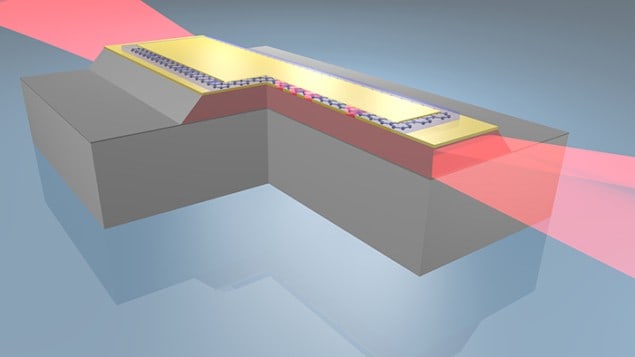
A new type of semiconductor laser has been created using the unique electronic properties of graphene. Designed in the UK by researchers at the University of Manchester, the prototype operates in the terahertz band and can be easily tuned to output radiation at specific wavelengths. The team says that its research could lead to the development of compact devices for a variety of different applications, from security scanning to medical imaging.
Terahertz radiation falls between the infrared and microwave regions of the electromagnetic spectrum and has the very useful property of passing through clothing, packaging and other common materials. As a result, terahertz radiation shows great promise in a wide range of applications, including security and medical scanning, drug and explosives detection as well as wireless communications. However, it has proven to be very difficult to create practical terahertz sources and detectors – so applications have so far been limited.
Coherent terahertz radiation can be created using quantum-cascade lasers, which were invented in 1994. These devices contain multiple quantum wells with energy bands that are split into subbands and minibands. When a bias voltage is applied to the laser, a periodic cascade of intersubband transitions is established. The population inversion necessary for terahertz lasing is then achieved through electrical injection.
‘Squeezing’ light
Terahertz light has wavelengths in the 100 μm – 1 mm range, so it must be “squeezed” into quantum-cascade lasers, which tend to be based on micron-sized structures. This is done using plasmons, which are bound states of electrons and photons that have much shorter wavelengths than the photons themselves. The plasmons are generated in metallic structures and the wavelength of the plasmons is an intrinsic property of the metal. This means that the output wavelength of a terahertz plasmon laser is fixed and cannot be retuned without changing the design.
“If you want to tune a laser, then preferably you want to do it electronically,” explains Subhasish Chakraborty at the University of Manchester.
To achieve electronic tuning, Chakraborty and colleagues utilized a unique property of graphene, which is a sheet of carbon just one atom thick. It turns out that the plasmon wavelength of graphene can be changed by placing it in an electric field – something that can be done by creating a gate structure similar to that used in a field-effect transistor.
They produced a laser containing a carefully designed, aperiodic series of quantum wells of various thicknesses made from gallium arsenide and aluminium gallium arsenide, on top of which they deposited a thin gold waveguide (see figure). Above this, they deposited an atomically thin layer of graphene. They made a series of subwavelength slits in the gold waveguide, forcing electrons to tunnel between the quantum wells in the form of plasmons in the graphene. Finally, they deposited a polymer electrolyte, which allowed them to apply a gate potential to the graphene and thereby control the plasmonic wavelengths it supports. This allowed the researchers to turn specific laser modes on and off, channelling the light energy into one or a few coherent modes and suppressing others.
Sharp modes
The team produced four prototype devices, all of which showed similar – although not identical – variation of the laser wavelength when the electrical potential was scanned from zero to 1 V. When zero potential was applied to the graphene, a large number of lasing modes were supported. When the potential was raised, however, the light emission was concentrated into a few specific, sharp modes defined by the positions of the slits.
Chakraborty stresses that the design is, at present, “a proof of concept”, and that more work needs to be done, notably to allow the researchers to control the voltage applied to each slit individually for maximum control of the lasing frequencies. Beyond that, he says, “we want to use a different gating technology consistent with the microelectronics industry”. He sees several potential applications in testing products for faults, airport scanners for concealed weapons or explosives and medical imaging. Further into the future, he believes that the rapid modulation of frequency possible with their devices could allow data transmission at terabit rates down fibre-optic cables.
Graphene plasmon expert Ortwin Hess of Imperial College London told physicsworld.com that in addition to the many potential practical applications of the laser, the theory underlying the research is fascinating. “I would love to see some direct dynamics,” he says. “How coherent is it? What kind of coherence statistics does it have? There’s a lot to explore once one has something like this…It really shows that, in graphene, plasmons play an important role, and it’s the coherent properties and also apparently the excitation of those that are very important.”
The research is described in Science.


